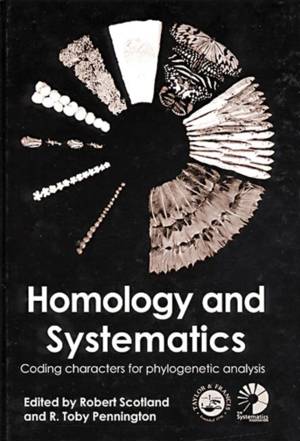
Je cadeautjes zeker op tijd in huis hebben voor de feestdagen? Kom langs in onze winkels en vind het perfecte geschenk!
- Afhalen na 1 uur in een winkel met voorraad
- Gratis thuislevering in België vanaf € 30
- Ruim aanbod met 7 miljoen producten
Je cadeautjes zeker op tijd in huis hebben voor de feestdagen? Kom langs in onze winkels en vind het perfecte geschenk!
- Afhalen na 1 uur in een winkel met voorraad
- Gratis thuislevering in België vanaf € 30
- Ruim aanbod met 7 miljoen producten
Zoeken
Homology and Systematics
Coding Characters for Phylogenetic Analysis
€ 228,95
+ 457 punten
Omschrijving
Systematists, comparative biologists, taxonomists and evolutionary biologists all concern themselves with the evolutionary relationships between animals and plants. Homology is the principle underlying these disciplines. When looking at groups of organisms, shared positional similarities (homologues) provide the raw data from which hypotheses of common ancestry (homology) may be suggested. In order to explore the relationship between homologues (characters) and particular hypotheses of common ancestry, complex matrices are devised, where homologues are coded, allowing theories of homology to be developed and tested. Practically nothing has been written about this matrix-building process and yet it is of fundamental importance to our understanding of diversity and evolutionary history. This book fills the gap by discussing the different ways observations are coded and the consequences for the resulting hypotheses. It takes a pragmatic approach and uses case studies as well as theoretical examples to offer practical solutions.
Specificaties
Betrokkenen
- Uitgeverij:
Inhoud
- Aantal bladzijden:
- 226
- Taal:
- Engels
- Reeks:
- Reeksnummer:
- nr. 58
Eigenschappen
- Productcode (EAN):
- 9780748409204
- Verschijningsdatum:
- 24/02/2000
- Uitvoering:
- Hardcover
- Formaat:
- Genaaid
- Afmetingen:
- 180 mm x 253 mm
- Gewicht:
- 635 g

Alleen bij Standaard Boekhandel
+ 457 punten op je klantenkaart van Standaard Boekhandel
Beoordelingen
We publiceren alleen reviews die voldoen aan de voorwaarden voor reviews. Bekijk onze voorwaarden voor reviews.








